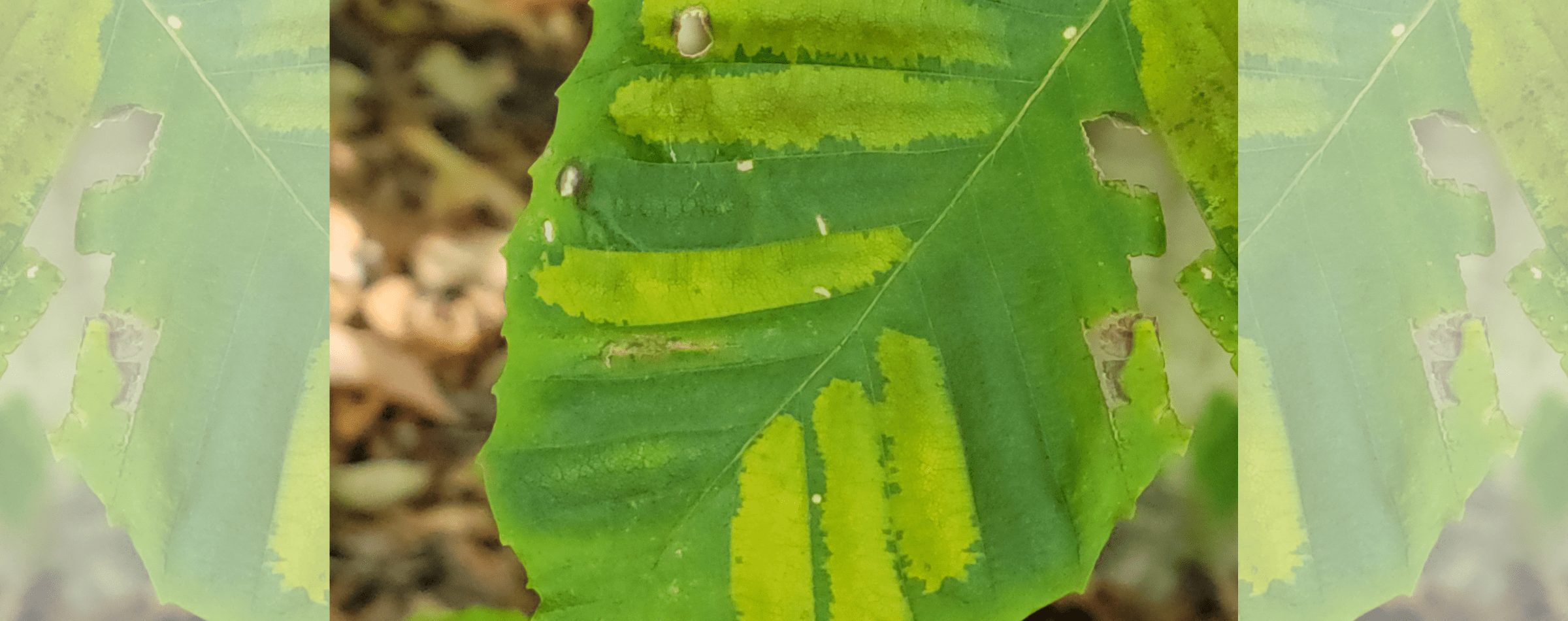Our American beech trees need your help. In early October, Executive Director Bill Schuster identified a stand of beech trees along Peck’s Road infected with the enigmatic Beech Leaf Disease (BLD). As the name implies BLD affects beech tree leaves resulting in a characteristic banding pattern between the leaf veins (see picture below). These start as a simple darkening between the veins and as the disease progresses the bands turn yellow, then brown, until the whole leaf becomes affected and begins to curl and die. The disease spreads very quickly and will kill any tree it infects. Large trees may take between six and 10 years to succumb to the disease, but smaller saplings often die within a year of infection.
BLD has been found in western, central, and southeastern New York but this is the first case identified in Black Rock Forest (first in Orange County?). First discovered in Ohio in 2012, scientists have yet to identify the causative agent behind this swiftly acting killer. Carta et al. (2020) identified a nematode in leaves displaying the characteristic banding associated with BLD (and in buds as well) and when these same nematodes were transplanted onto a healthy leaf it soon showed BLD symptoms. This led to the hypothesis that this nematode – Litylenchus crenatae mccannii (LCM) – was responsible for the disease. However, since then other scientists (Burke et al. 2020; Ewing et al. 2021) have discovered LCM living in healthy leaves. The continued search for BLD’s cause has led to examination of many other microorganisms as scientists around the country try to discover the cause of this disease in the hope it will lead to a means to treat it and/or limit its spread. Since the cause of BLD is unknown there is no known treatment and it is not even known how the disease spreads from one stand to another.
Black Rock Forest needs your help in identifying any additional trees infected with BLD so they can be reported to the Department of Environmental Conservation. Our staff have chosen an aggressive approach to this new forest pest and plan to promptly remove any tree found with the disease in the hope of stopping the spread. If you find any beech trees in Black Rock Forest exhibiting the characteristic leaf banding pattern shown in the picture below, please take a picture, identify the location, and send it to science@blackrockforest.org.
Burke, D. J., Hoke, A. J., & Koch, J. (2020). The emergence of beech leaf disease in Ohio: Probing the plant microbiome in search of the cause. Forest Pathology, 50(2), e12579. https://doi.org/10.1111/efp.12579
Carta, L. K., Handoo, Z. A., Li, S., Kantor, M., Bauchan, G., McCann, D., Gabriel, C. K., Yu, Q., Reed, S., Koch, J., Martin, D., & Burke, D. J. (2020). Beech leaf disease symptoms caused by newly recognized nematode subspecies Litylenchus crenatae mccannii (Anguinata) described from Fagus grandifolia in North America. Forest Pathology, 50(2), e12580. https://doi.org/10.1111/efp.12580
Ewing, C. J., Slot, J., Benítez, M.-S., Rosa, C., Malacrinò, A., Bennett, A., & Bonello, E. (2021). The Foliar Microbiome Suggests that Fungal and Bacterial Agents May be Involved in the Beech Leaf Disease Pathosystem. Phytobiomes Journal, PBIOMES-12-20-0088-R. https://doi.org/10.1094/PBIOMES-12-20-0088-R


